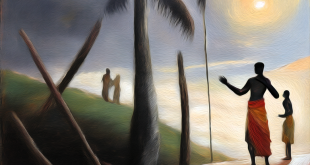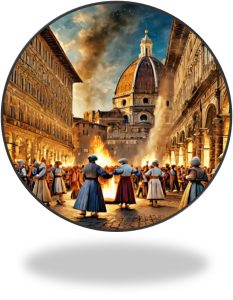 The vanity behind appearance, a theme that accompanies us in everyday life
The vanity behind appearance, a theme that accompanies us in everyday life
The magic of bonfires, their dancing light and the warmth that envelops us remind us of the fleeting nature of life and the beauty of moments shared under the starry sky. Phrases, quotes and aphorisms revolve like sparks around the concept of the Bonfire of the Vanities. For Sandro Penna https://www.goodreads.com/book/show/21950342-this-strange-joy, perhaps life goes out in a bonfire of stars in love. Jiří Žáček https://www.goodreads.com/book/show/23351683-text-appeal, on the other hand, claims that when we look at the flames of a bonfire, we feel a million years younger. In the opinion of an anonymous person, life is that thing that happens between one bonfire and another. Finally, Fabrizio Caramagna reminds us that many sparks fall from the bonfire, they seem like fleeting shooting stars.
 The memory of a friar has remained imprinted in the history of Florence, in the debate on morality and the use made of art. We offer you some places in Florence https://www.cntraveler.com/destinations/florence connected to him. Piazza della Signoria, where the famous Bonfire of the Vanities was held, an event in which objects considered sources of sin were burned. Today, in Piazza della Signoria, a circular plaque with bronze letters commemorates the point where the body of that friar, a controversial and prophetic figure in Florentine history, who left an indelible mark on the city, was burned. In the Convent of San Marco, however, where Girolamo Savonarola had his personal cell, exhibited in that same cell, you will find some objects linked to his figure. Finally, Piazza Savonarola, adorned with a monument to the Dominican friar, is located just off the avenues of Florence and offers an inviting public green space for a stop during walks in the city. The digital images of Dastilige Nevante, as well as a special video, illustrate and enrich the reading of this article.
The memory of a friar has remained imprinted in the history of Florence, in the debate on morality and the use made of art. We offer you some places in Florence https://www.cntraveler.com/destinations/florence connected to him. Piazza della Signoria, where the famous Bonfire of the Vanities was held, an event in which objects considered sources of sin were burned. Today, in Piazza della Signoria, a circular plaque with bronze letters commemorates the point where the body of that friar, a controversial and prophetic figure in Florentine history, who left an indelible mark on the city, was burned. In the Convent of San Marco, however, where Girolamo Savonarola had his personal cell, exhibited in that same cell, you will find some objects linked to his figure. Finally, Piazza Savonarola, adorned with a monument to the Dominican friar, is located just off the avenues of Florence and offers an inviting public green space for a stop during walks in the city. The digital images of Dastilige Nevante, as well as a special video, illustrate and enrich the reading of this article.
 The Book of Ecclesiastes https://www.amazon.in/Ecclesiastes-Book-King-James/dp/1515440982, a text contained in the Jewish and Christian Bible, was written in Judea in the 5th or 3rd century BC. by an unknown author. The book begins with the words “Vanity of vanities, everything is vanity”, a phrase that expresses the transience and futility of many earthly things. Exploring wisdom, foolishness and madness, investigates everything that is done under heaven. As regards, however, the search for joy and pleasure, he concludes that nothing we crave can completely satisfy us. Unfortunately, only at the end do we discover that everything is chasing the wind. Vanity and ephemerality, concepts that are deeply intertwined and reflect the transitory nature of life. In the spiritual context, vanity indicates the ephemeral nature of everything that exists and reminds us of the fragility and brevity of life; the ephemeral, on the other hand, underlines the transitory nature of everything that surrounds us. Both invite us to reflect on our existence and search for meaning beyond superficial appearances.
The Book of Ecclesiastes https://www.amazon.in/Ecclesiastes-Book-King-James/dp/1515440982, a text contained in the Jewish and Christian Bible, was written in Judea in the 5th or 3rd century BC. by an unknown author. The book begins with the words “Vanity of vanities, everything is vanity”, a phrase that expresses the transience and futility of many earthly things. Exploring wisdom, foolishness and madness, investigates everything that is done under heaven. As regards, however, the search for joy and pleasure, he concludes that nothing we crave can completely satisfy us. Unfortunately, only at the end do we discover that everything is chasing the wind. Vanity and ephemerality, concepts that are deeply intertwined and reflect the transitory nature of life. In the spiritual context, vanity indicates the ephemeral nature of everything that exists and reminds us of the fragility and brevity of life; the ephemeral, on the other hand, underlines the transitory nature of everything that surrounds us. Both invite us to reflect on our existence and search for meaning beyond superficial appearances.
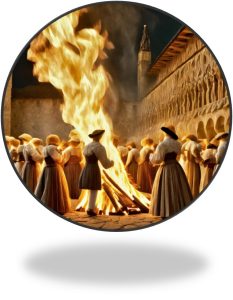 Bonfire of the Vanities, https://www.audiobooks.com/audiobook/721061?refId=40912&msclkid=6cc7e557bd4d1d63e8cc834356ba4f55 was a historical event that took place in Florence on 7 February 1497. This event was organized after the expulsion of the Medici, when the followers of Girolamo Savonarola seized and burned a large quantity of objects considered sources of sin. Among these objects there were mirrors, cosmetics, make-up of various kinds, luxurious clothes and musical instruments. Indeed, some works by the famous painter Sandro Botticelli, dedicated to classical mythology, were thrown into the stake. It is said that Botticelli himself was fascinated by Savonarola’s theses and participated in the destructive act. Girolamo Savonarola, a Dominican friar born in Ferrara in 1452, arrived in Florence in 1490. His preaching had as its theme the Apocalypse and the need to repent and purify oneself from all sins before the end of the world. His words were directed against the representatives of the Church, the men of government, the artists and the intellectuals. His speech impressed the masses and brought him closer to the weakest and humblest, putting him in conflict with the powerful who considered his criticisms of the government and the Church inappropriate. In the following years, the Medici family fell out of favor and Florence became a Republic.
Bonfire of the Vanities, https://www.audiobooks.com/audiobook/721061?refId=40912&msclkid=6cc7e557bd4d1d63e8cc834356ba4f55 was a historical event that took place in Florence on 7 February 1497. This event was organized after the expulsion of the Medici, when the followers of Girolamo Savonarola seized and burned a large quantity of objects considered sources of sin. Among these objects there were mirrors, cosmetics, make-up of various kinds, luxurious clothes and musical instruments. Indeed, some works by the famous painter Sandro Botticelli, dedicated to classical mythology, were thrown into the stake. It is said that Botticelli himself was fascinated by Savonarola’s theses and participated in the destructive act. Girolamo Savonarola, a Dominican friar born in Ferrara in 1452, arrived in Florence in 1490. His preaching had as its theme the Apocalypse and the need to repent and purify oneself from all sins before the end of the world. His words were directed against the representatives of the Church, the men of government, the artists and the intellectuals. His speech impressed the masses and brought him closer to the weakest and humblest, putting him in conflict with the powerful who considered his criticisms of the government and the Church inappropriate. In the following years, the Medici family fell out of favor and Florence became a Republic.
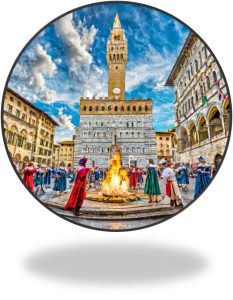 The descent of the French king Charles VIII into Italy, to reclaim the kingdom of Naples, seemed to confirm Savonarola’s sermons on the need to overthrow the old oppressive powers. Savonarola retained his prestige and continued to preach, while Pope Alexander VI, who opposed him, was forced to wait for Charles VIII’s escape before excommunicating the Dominican friar and decreeing his death. The Bonfire of the Vanities represented the peak of Savonarola’s vehemence against prelates, rulers and everything that could be a vehicle of sin. In Piazza della Signoria, books, musical instruments, paintings and objects of beauty such as mirrors, clothes and cosmetics were burned. This event marked the end of Savonarola’s preaching period, and in 1498, the friar was excommunicated and condemned to the stake. Not only did the consequences of the Bonfire of the Vanities mark a turning point in the history of Florence and the Church https://www.thriftbooks.com/w/florence-and-northern-tuscany-with-genoa_edward-hutton/38978338/#edition=67014736&idiq=57441829, but they had an impact on the artistic and cultural production of the time. In fact, as well as being a moment of tension between spirituality and Renaissance culture, that event raised questions about morality, the power of the Church and the use of art. In summary, that bonfire represented a moment of religious fervor and political change, but also an irreparable loss of works of art and culture.
The descent of the French king Charles VIII into Italy, to reclaim the kingdom of Naples, seemed to confirm Savonarola’s sermons on the need to overthrow the old oppressive powers. Savonarola retained his prestige and continued to preach, while Pope Alexander VI, who opposed him, was forced to wait for Charles VIII’s escape before excommunicating the Dominican friar and decreeing his death. The Bonfire of the Vanities represented the peak of Savonarola’s vehemence against prelates, rulers and everything that could be a vehicle of sin. In Piazza della Signoria, books, musical instruments, paintings and objects of beauty such as mirrors, clothes and cosmetics were burned. This event marked the end of Savonarola’s preaching period, and in 1498, the friar was excommunicated and condemned to the stake. Not only did the consequences of the Bonfire of the Vanities mark a turning point in the history of Florence and the Church https://www.thriftbooks.com/w/florence-and-northern-tuscany-with-genoa_edward-hutton/38978338/#edition=67014736&idiq=57441829, but they had an impact on the artistic and cultural production of the time. In fact, as well as being a moment of tension between spirituality and Renaissance culture, that event raised questions about morality, the power of the Church and the use of art. In summary, that bonfire represented a moment of religious fervor and political change, but also an irreparable loss of works of art and culture.
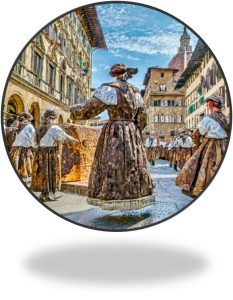 The vanity behind appearances—a theme that accompanies us through everyday life. Drawing inspiration from this concept, digital artist Dastilige Nevante reconnects with the Renaissance era of Florence, infused with the fervent teachings of Friar Girolamo Savonarola. Through his artistic lens, Nevante has crafted a thought-provoking gallery of images that delve into the intricate duality of surface beauty and inner truth. These evocative visuals are further enriched by a poignant soundtrack from FiftySounds, creating a harmonious dialogue between the past and present, art and music, vanity and authenticity.
The vanity behind appearances—a theme that accompanies us through everyday life. Drawing inspiration from this concept, digital artist Dastilige Nevante reconnects with the Renaissance era of Florence, infused with the fervent teachings of Friar Girolamo Savonarola. Through his artistic lens, Nevante has crafted a thought-provoking gallery of images that delve into the intricate duality of surface beauty and inner truth. These evocative visuals are further enriched by a poignant soundtrack from FiftySounds, creating a harmonious dialogue between the past and present, art and music, vanity and authenticity.
 Meeting Benches World art in all forms
Meeting Benches World art in all forms





